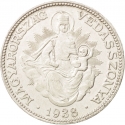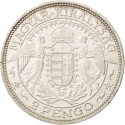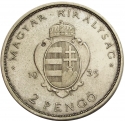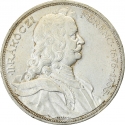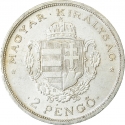You are about to finish your registration. Please check your mailbox (including spam folder). There should be a letter with a confirmation link. Check setting to make sure that your e-mail address is correct.
Send letter againDescription
Miklós Horthy de Nagybánya (1868–1957) was a Hungarian admiral and statesman, who served as Regent of the Kingdom of Hungary between World Wars I and II and throughout most of World War II, from 1 March 1920 to 15 October 1944.
Engraver: Lajos Berán
Obverse

|
Depicts an older portrait of Franz Liszt facing to the right. Below the beaded edge pattern running around the rim of the coin, the inscription reads, "IN MEMORY OF FRANZ LISZT, THE GREAT HUNGARIAN COMPOSER." Below the portrait, the birth and death years "1811-1886" are placed at the edges, each flanked by a floral motif. Above the years, the engraver's privy mark is visible. LISZT • FERENC • A • NAGY • MAGYAR • ZENEKÖLTŐ • EMLÉKÉRE • |
|---|---|
Reverse

|
Depicts Hungary's small coat of arms with a crown, illustrated in a Baroque style, adorned with a wreath made of oak leaves on the left and laurel leaves on the right. The bottom edge of the wreath is tied with a ribbon. The issuance year "1936" is split into two parts and placed on either side of the coat of arms, with the mint mark "BP." located beneath the ribbon. The upper inscription of the coin reads "HUNGARIAN KINGDOM," decorated with a floral motif at each end. The lower inscription shows the denomination "2 PENGŐ." MAGYAR KIRÁLYSÁG |
| Edge |
2 Pengő
Regency
50th Anniversary of Death of Franz Liszt
KM# 515 Unger# 1514 Huszar# 2264 Adamo# P7.3
50th Anniversary of Death of Franz Liszt


